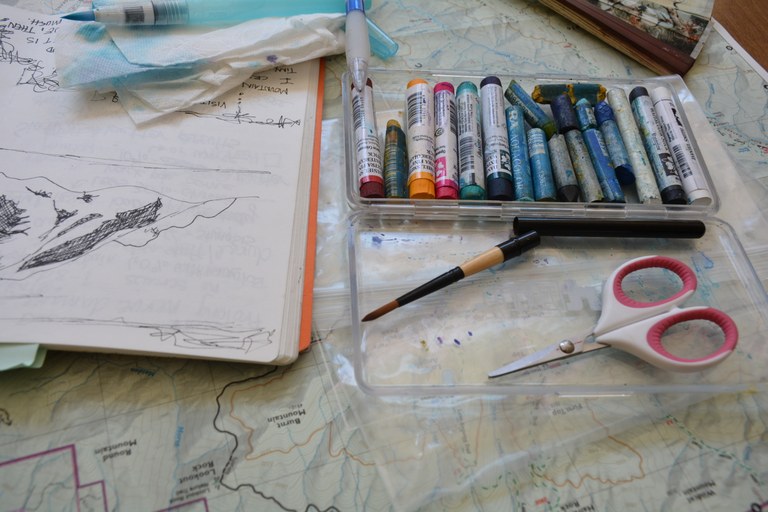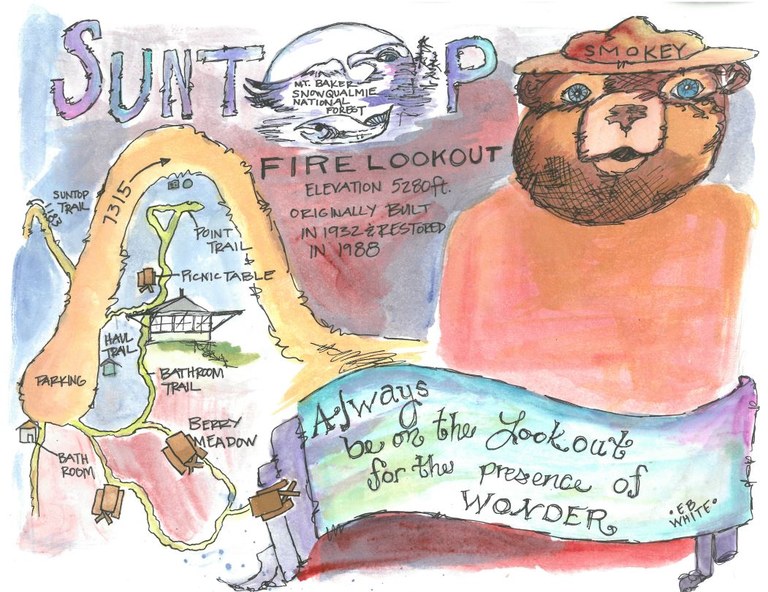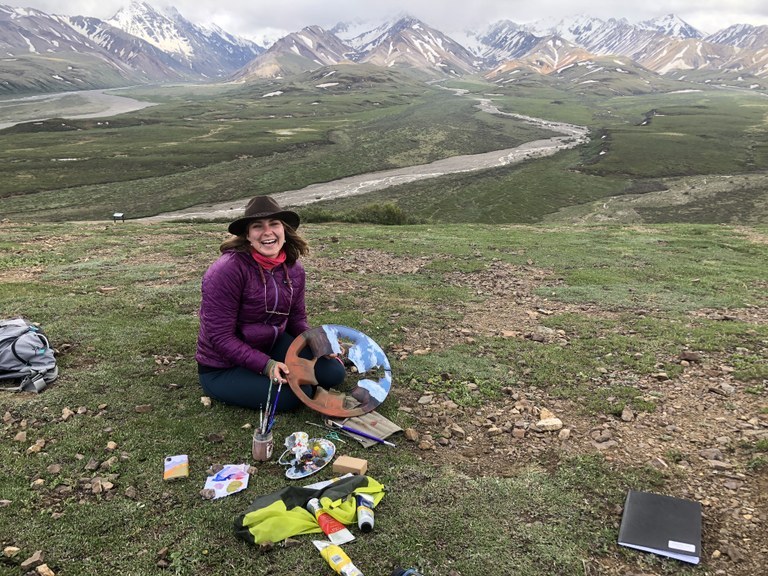How to Make Art on Trail
By Jessi Loerch
Art doesn’t need to be complicated, and it doesn’t need to be intimidating. It can be as simple as a small pad of paper and a pencil. Cole Adams is an artist and an enthusiastic hiker and traveler. Whenever she hikes, she carries her Ten Essentials. As an artist, she also carries her art essentials.
Here are her top five tips to get you started making art on trail — and her recommendations on the best art tools to hike with.
 Cole Adams suggests making maps as an easy way to make art when you’re out on trail or camping. Self portraits or sketches of wildlife are also fun. Art by Cole Adams.
Cole Adams suggests making maps as an easy way to make art when you’re out on trail or camping. Self portraits or sketches of wildlife are also fun. Art by Cole Adams.
Give yourself time
Making art takes time, so if you want to paint or sketch on trail, keep that in mind. You’ll either want to hike by yourself or go with a friend who also wants to make art — or who is simply willing to hang out for a long time.
Be prepared
Making art doesn’t require much; a pencil and a notebook are plenty. But if you want to get fancier, find other tools to make your art. When you pack your backpack, toss in a few art essentials with your other essentials. (See next page for ideas.) Of course, be careful that everything you bring with you comes back out with you.
Start simple
Look for shapes that are easy to draw and iconic. Quickly sketch the shape of Mount Rainier and then use watercolor to fill it in. Or draw a national forest sign or trail sign. Don’t worry about being perfect, just start creating. Over time, your skill will improve naturally as you practice. And don’t worry about colors. There are no color police; you can make the fawn teal and purple. A side note: Let go of perfection. The act of making art is way more important than the result.

Art by Cole Adams. Photo by Teddy Wingo.
Make maps
A map is a great way to document your journey. You can sketch the trail or a campground and draw small little images to tell the story of what happened on your trip.
Make more
While painting and sketching are easy and convenient on the trail, don’t stop there. Consider how your art can inspire other art later. Perhaps your art on trail will turn into a more polished sketch or painting. Or maybe it will inspire a tapestry, wall hanging or other art.
Tools
- Watercolor: Watercolor is extremely easy to use on trail. It’s portable, it doesn’t matter if the paint dries out, and it dries quickly on the page. You have many options for watercolor on trail.
- Mini watercolor kits: Small, portable watercolor kits are available at many art stores or online. They’re easy to pack and offer a variety of colors in a small space.
- Watercolor pens: These pens come pre-loaded with color. They have a brush tip and a reservoir that holds colored ink. They produce vivid color; to get a more subtle effect, combine them with another brush with plain water. Ink tends to pool on the tips if these pens are carried in a pack for long. Use a small towel or Q-tip to sop up paint.
- Watercolor crayons: These can be used three different ways. Use them as a standard crayon; get a brush wet and pull color off of the crayon, or draw and then use a wet brush to move the color around on the page. Nice versions of these crayons can be expensive, but they’re an excellent tool.
- Watercolor pencils: These pencils look simply like a colored pencil when used alone. But you can also add water to get a softer look or blend colors.
- Water brush: A simple brush with a reservoir that holds water; can be used with any type of watercolor.

Art by Cole Adams.
- Pens or pencils: A fine-tipped, waterproof pen and a pencil make a great base for your art kit. They can be used alone or with watercolors.
- Index cards: Index cards have a number of uses. They make handy test pages for watercolor. They’re also easy to carry if you have a basecamp and are just taking a short hike. And, if you decide something isn’t working for you in your sketchbook, you can tape an index card over it and have a fresh start.
- Notebook: There are endless options for notebooks out there. When you look for a notebook, keep a few things in mind. You want it to feel good in your hand. You want it to be sturdy (sewn notebooks last longer than those that are stapled). And you want it to be a reasonable size for your pack. For winter, consider a waterproof notebook like Rite in the Rain. Experiment to find a notebook that works best for you.
- Paper towels: These are useful for cleaning brushes or dabbing up extra water or paint on a page.


